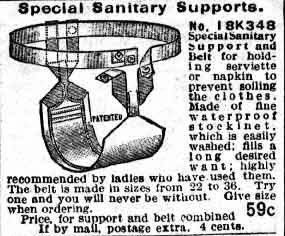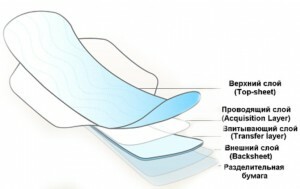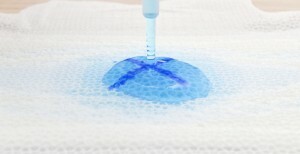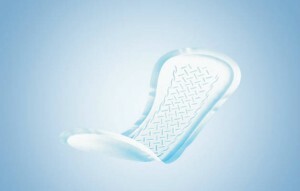After the onset of puberty and before menopause every month for 4-5 days, the fair sex is menstruating. This is the main feature of female physiology. In order to feel as comfortable as possible in this period, it is sufficient to use gaskets properly. These products reliably absorb all the emissions, providing a feeling of freshness and purity. In adult women, no difficulties arise. They easily choose the suitable means of hygiene. But young girls are often asked questions, what are gaskets for, and how to use gaskets correctly.
It may seem that what is needed for a gasket and how to apply it is understandable and so. But if you consider these issues in detail, you can learn many interesting facts. Let's start from the very beginning.
A bit of history

The history of gaskets begins in Ancient Egypt. Rich Egyptians as a hygienic means used tampons made of papyrus. Those who could not afford this expensive material used during a month's thick tissue. It was washed and reused.
Ancient Romans made pads of cotton material. They also made tampons of wool collected in a ball. Ancient Greek women used as a hygienic means scraps of soft fabric, felt, silk.
In medieval Europe, women did not pay much attention to hygiene during menstruation. Instead of pads, they used lower skirts.
The prototype of modern hygiene products appeared during the First World War. Then the nurses noticed that the celluloton material( like cotton wool) absorbs blood well. They began to use it as a means of hygiene during menstruation.
Thanks to the opening of nurses, the first gaskets appeared. Their industrial production began in 1920.These products are called "Celunap".They were fastened to a special belt tied at the waist. Initially, gaskets did not have a significant demand, because women were embarrassed to acquire them.
Pads became very popular only in the 60's. In this period, hygiene products were created, similar to modern ones. They were attached to the laundry with a special adhesive layer. It was quite convenient to use them. From this period, manufacturers began to pay attention to the development of convenient hygiene products.
Types and structure of

In the modern market a wide variety of hygiene products is represented. If the question arises, what are the differences between gaskets and how to choose the optimal model, you need to study their features in detail.
Gaskets differ in a large number of parameters: the material of manufacture, size, level of absorbency. Different companies specializing in the production of these products are constantly improving the performance characteristics of these products. They make them more reliable, and also convenient and practical.
All modern gaskets have a standard look. They consist of the following parts:
1. The outer layer of - comes into contact with the skin, it must quickly pass the secretions. It is made of thin smooth cotton, processed in a special way, or from artificial material( in appearance it resembles a grid).
- The advantage of the cotton surface is its naturalness. It does not provoke irritation. But such a surface can remain moist, which is not very pleasant.
- The artificial material always remains dry. However, contact with it on the delicate skin can form irritation.
2. The inner layer of - it absorbs the discharge. Make it from cellulose or from a filler, called granulat-airlite.
Cellulose gaskets absorb large amounts of secretions, they do not irritate the skin, they are affordable. Their only negative is the size. They are quite thick( 7-10 mm) and bulky. They are inconvenient to wear with tight clothes.
Dimensions of gaskets with filler are much smaller. Its granules, absorbing excretions, turn into gel, which excludes the possibility of leakage. The thickness of such hygienic means is only 3 mm. You can wear them with any clothes, they are absolutely invisible. It should only be taken into account that the filler can cause irritation.
The outer( lower) layer can be a polyethylene( budget variant) or a hydrophobic nonwoven material. The latter misses the air, so it guarantees a more comfortable feeling when the gasket is in the underpants. It is better to give preference to products with a "breathing basis."
Manufacturers offer hygiene products of different shapes and lengths. This allows women to choose the ideal option. And why do you need a gasket supplemented with wings? The answer is unambiguous - to fix the hygienic means and to guarantee protection against leakage on the sides. Wings are very thin. They are securely attached to the laundry, preventing the shim from sliding.
Absorption coefficient

Considering how to choose the gaskets, special attention should be paid to the absorption coefficient. All hygiene products are divided into the following categories:
- normal;
- super;
- super-plus.
The absorbency level is indicated by the droplet scale. The package shows from 3 to 7 drops. The more droplets are drawn, the higher the absorbency of the pads.
With abundant discharge, you should choose products with 5-7 drops. They are ideal for the first days of menstruation. With allocations of medium intensity, regular gaskets( 3-4 drops) will do. Ultra-thin pads( 2 drops) can be used for weak discharge. For example, on the last day of menstruation.
There are also night gadgets. They are long and have a high level of absorbency to provide a sufficient level of protection in the supine position.
What is different from tampons
In the process of studying the range of hygiene products, a logical question arises: what are the spacers different from tampons, because they perform a similar function. The difference is in the principle of use. Gaskets are dressed on linen and absorb the menstrual discharge that flows out of the vagina. Tampons, however, having a round oblong shape and compact dimensions, are inserted directly into the vagina and absorb the secretions inside it.

When to change hygiene products

Many people are interested in the question of how to use the gasket correctly. That is, how often it needs to be changed.
Modern hygiene products, if the level of absorbency is selected correctly, virtually eliminate the possibility of leakage. But this does not mean that you do not need to change them. During the day, the change of gaskets should be periodic. Gynecologists recommend wearing a new hygiene product when the used gasket is filled by 1/3( about every 2-6 hours).To do this is important for several reasons:
- Upon contact with the air, emissions begin to produce an unpleasant odor from .
- Menstrual blood is a favorable environment for the reproduction of bacteria. And since during the menstrual cervix ajar, there is a high probability of earning an infection.
How to properly dress
If a girl learns how to use gaskets correctly, she can minimize the probability of leakage of discharge. That is why it is important to understand the algorithm of using the gasket. It is very simple and consists of the following:
- First you need to wash your hands thoroughly. Only then you can get the gasket out of the package. It is desirable that each product be individually packaged. This ensures their sterility.
- It is better to change the hygiene after taking a shower. Alternatively, you can use wet wipes.
- After preparing your body, remove the protective tape from the gasket and stick it with the sticky side to the inside surface of the laundry.
These elementary rules teach you how to put the gasket correctly.
Answers to important questions
After understanding how to correctly apply gaskets, you can move on to other important issues. The main ones are:
- What are the features of storing gaskets? It is important to store them in a sealed state( in a dry place).Shelf life of the gaskets is 3 years. It is recommended to discard the product at its expiration.
- Are the pads harmful? Gaskets are made from safe materials, so they are absolutely harmless. There are scented products, as well as models of bright colors, which, according to gynecologists, can provoke irritation, as well as allergies. Given this fact, it is better to choose simple gaskets, without aromatic additives and dyes.
Having studied in detail the question of why girls and women need gaskets, it can be argued that they are necessary to feel the maximum comfort of maintaining the active rhythm of life during menstruation.
